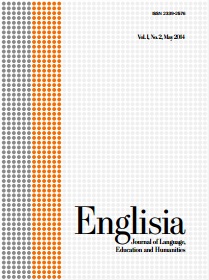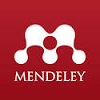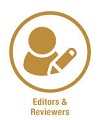GAYO LANGUAGE IS OLD MALAY (A DIALECTOLOGY STUDY: THE LANGUAGE CHANGE)
DOI:
https://doi.org/10.22373/ej.v1i2.28Keywords:
language variation, Gayo, MalayAbstract
An interdisciplinary linguistic which studies the problem on language variation is so called Dialectology. The variation of language happens on the usage that is caused by the change of social environment and place for ages. Language variation can be found in the form of accent, sub dialect, dialect, or that of language. Studying a language variation means also to trace the language history. Geographically, language variation can show where the speaker comes from. Linguistics distinctions analyzed in dialectology are phonetics, morphemic, and lexical variations. However, in this study, phonological and lexical variations are discussed. Glosses used are Ogden's 850 basic words which have been translated into Bahasa. The research subjects are 18 Gayo native speakers. Six of them become primary informants and the rests are as secondary ones. Methods of acquiring data used are cakap-simak (speak and listen) as well as tulis-rekam (write and record). The discovered data from the informants are crosschecked with the standardized words of Kamus Besar Bahasa Indonesia (Indonesian Great Dictionary). Then, the distance of word variations are determined by using dialectometry formula. The result are: 165 words = 19,41% lexical differences, 305 words = 35,88% phonetically differences, and 380 words = 44,71% without difference, neutral or zero. By regarding 1% data error tolerant, it can be concluded that Gayo language is Old Malay that has “accent variation = 20,41%" compared to New Malay or Bahasa Indonesia.References
Abdussalam. (2012). Hanya 850 Kata Gayo-Indonesia-Inggris untuk Komunikasi Sehari-hari. Medan: Program Studi Linguistik Sekolah Pascasarjana USU.
Aceh.tribunnews.com. (2012). Kajian Arkeologis Suku Batakdari Gayo. Retrieved from http://aceh.tribunnews.com/2011/12/12/kajian-arkeologis-suku-batak-dari-gayo
Ayatrohaedi. (1983). Dialektologi: Sebuah Pengantar. Jakarta: Pusat Pembinaan dan Pengembangan Bahasa.
Brown, H Douglas. (2008). Prinsip Pembelajaran dan Pengajaran Bahasa (transl). (5th Edition). Jakarta: US Embassy.
Chambers, J.K. and Trudgill, P. (1980). Dialectology. Cambridge, New York, Mel-bourne: Cambridge University Press.
Crystal, D. (1992). The Cambridge Encyclopedia of Language. Cambridge: Cam-bridge University Press.
Hornby, A.S. (1999). Oxford Advanced Learner’s Dictionary. 4th Impression. Oxford: Oxford University press.
Ibrahim, M. (2001). Mujahid Dataran Tinggi Gayo. Takengon: Yayasan Maqama-mmahmuda.
Kompasiana. (2012) retrieved from http://sejarah.kompasiana.com/2011/07/05/ menelusuri-sejarah-suku-gayo-melalui-dongeng-dan-bukti-arkeologi/
Laksono, Kisyani. (2001). Bahasa Jawa di Jawa Timur Bagian Utara dan Lex.Dambangan: Kajian Dialektologis. Ringkasan Disertasi.
Lauder, Multamia RMT. (1993). Pemetaan dan Distribusi Bahasa-Bahasa di Tange-rang. Jakarta: Pusat Bahasa.
Lauder, Multamia RMT. (2002). “Reevaluasi Konsep Pemilah Bahasa dan Dialek untuk Bahasa Nusantaraâ€, (Jurnal) Makara, Sosial Humaniora, Vol.6, No.1 Juni 2002 (file pdf).
Mahsun, (1995). Dialektologi Diakronis: Sebuah Pengantar. Yogyakarta: Gadjah Mada Uni¬ver¬sity Press.
Nasution, Farizal & Sembiring, Asli Br. (2007). Budaya Melayu. Medan: Badan Perpustakaan dan Arsip Daerah Provinsi Sumut.
Nonki. (2010). Asal Usul Bahasa Melayu. Retrieved from http://massahar-tiga.Lex.Dogspot.com/2010/03/asal-usul-bahasa-melayu-sebuah-kajian.html
Nothofer, Bernd. (1980). Dialektgeographische Untersuchungen in West-Java und im Westlichen Zen¬tral-Java. Wiesbaden: Otto Horrassowitz.
Nur, W. W. (2011). Menelusuri sejarah suku gayo melalui dongeng dan bukti arkeologi. Retrieved from http://sejarah.kompasiana.com/2011/07/05/ men-elusuri-sejarah-suku-gayo-melalui-dongeng-dan-bukti-arkeologi/
Schwarz, Chaterine., Davidson, George., et al. (1992). Chambers English Dictionary, (Editors). London: Clays Ltd. St Ives plc.
Sibarani, Robert & Hanafiah, Ridwan. (1999). Geografi Dialek Bahasa Mandailing. Medan: Departemen Pendidikan dan Kebudayaan, Bagian Proyek Pembinaan Bahasa dan Sastra Indonesia dan Daerah Sumatera Utara.
Sudaryanto. (1993). Metode dan Aneka Teknik Analisis Bahasa: Pengantar Penelitian Wahana Kebudayan Secara Linguistis. Yogyakarta: Duta Wacana University Press.
Tanoh Aceh. (2012). 200 Siswa di Takengon Jalani Tes DNA. Retrieved from http://www.tanohaceh.com/?p=1129
Thomas, Alan R. (1988). Methods in Dialectology. Philadelphia: Multilingual Mat-ters Ltd.
Wikipedia. (2011). Aceh. Retrieved from http://en.wikipedia.org/wiki/Aceh
Downloads
Published
Issue
Section
License
Proposed Policy for Journals That Offer Open Access
Authors who publish with Englisia journal agree to the following terms:
- Authors retain copyright and grant the journal right of first publication with the work simultaneously licensed under a Creative Commons Attribution License that allows others to share the work with an acknowledgement of the work's authorship and initial publication in this journal.
- Authors are able to enter into separate, additional contractual arrangements for the non-exclusive distribution of the journal's published version of the work (e.g., post it to an institutional repository or publish it in a book), with an acknowledgement of its initial publication in this journal.
- Authors are permitted and encouraged to post their work online (e.g., in institutional repositories or on their website) prior to and during the submission process, as it can lead to productive exchanges, as well as earlier and greater citation of published work (See The Effect of Open Access).






